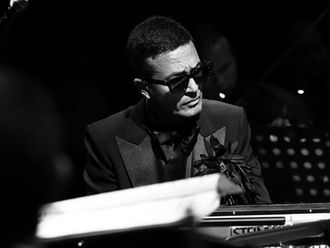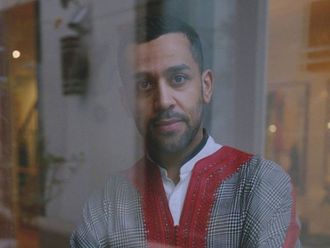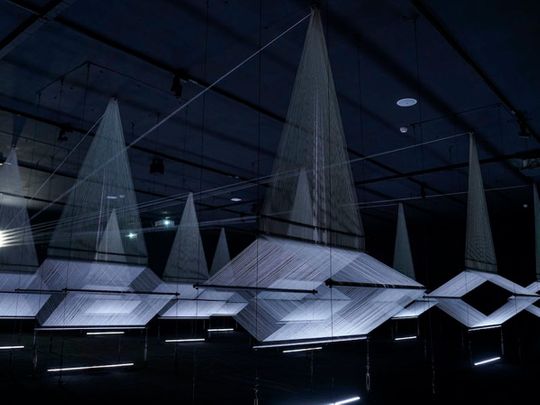
Within the Western Hajj Terminal at the King Abdulaziz International Airport in Jeddah a different scene from the usual throng of pilgrims heading to Mecca and Madinah for the important Muslim pilgrimage is taking place. Instead, a multitude of carefully curated heritage Islamic artworks juxtaposed with newly commissioned contemporary Islamic works of art have been staged under the enrapturing billowing canopies in the Aga Khan-award winning architectural design of American studio Skidmore, Owings & Merrill during the 1980s. The works, so meticulously placed in dialogue, communicate the past and present heritage of Islamic art and culture for the inaugural Islamic Arts Biennale.
Staged by the Diriyah Biennale Foundation, erected in 2020 by the Ministry of Culture to produce Saudi Arabia’s first-ever art biennales, the Islamic Arts Biennale is groundbreaking and historical on many levels. Firstly, not in several decades has such a large group of Islamic artworks from across the Muslim world been staged in unison. Moreover, the biennale also signifies the first time ever that such a grand showing of Islamic art is staged in the birthplace of Islam.
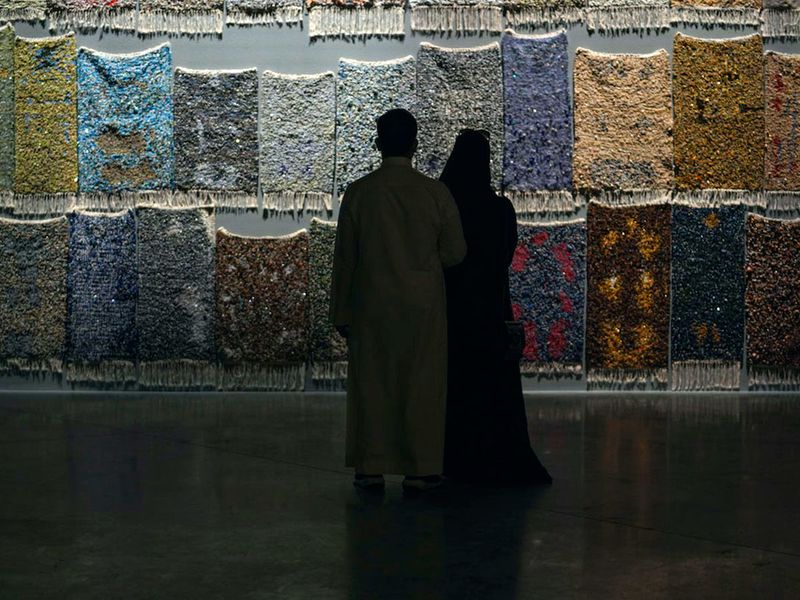
Staged under the theme of ‘Awwal Bait’ meaning ‘first house’ in Arabic, on view are 280 works of Islamic historical objects and artifacts coupled with over 40 established and emerging artists from around the globe, over 50 new commissions, and more than 15 never-before-exhibited artifacts. The dialogue between the artworks on show offers visitors an experience that is both mystical, engaging, and transcendent. It has been curated by a team of specialists, including Sumayya Vally, a South African architect, and artistic director of the biennale, alongside prominent Saudi scholar and archaeologist Saad Al Rashid; Omniya Abdel Barr, an Egyptian architect and Barakat Trust Fellow at the Victoria & Albert Museum and Julian Raby, director emeritus of the National Museum of Asian Art at the Smithsonian Institution in Washington D.C.
While the biennale showcases contemporary art produced by artists located throughout the Muslim world, Saudi Arabian heritage and artistic talent makes a special appearance, with 18 Saudi artists presenting over 40 works. These include pieces by Muhannad Shono, Basmah Felemban, Nora Alissa, Reem Al Faisal, Sarah Brahim and Saudi architecture firm Bricklab. Contemporary works of art are staged eloquently alongside historical works loaned from 13 institutions in the Kingdom including the National Museum, the King Abdulaziz Public Library, King Abdulaziz Waqf Libraries Assembly (KAWLA), the King Fahad National Library, the General Presidency for the Affairs of the Grand Mosque and the Prophet’s Mosque and the King Faisal Center for Research and Islamic Studies. The historic works hail from Kuwait, Egypt, Tunisia, Qatar, Oman, Mali, Uzbekistan, and Azerbaijan.
The visitor will become transfixed by the works not just for the history and contemporary culture they reveal, but also do their curation and specific design and architectural setting thanks to award-winning architecture studio OMA that designed the interlocking galleries. The mission was to guide the visitor from an experience of darkness towards light—just like that of a spiritual journey. Once the spectator concludes the winding series of -galleries, they enter out into an area with contemporary artworks positioned underneath the gently swaying canopies that is -titled Hijrah, according to the Prophet’s migration from Mecca to Medinah to escape persecution. It is the area with the most light as if it were the place where spiritual realisations occur. The -metaphorical journey from darkness to light is like that of the soul towards the idea of resurrection and transcendence from earthly suffering and the realisation of divine love.
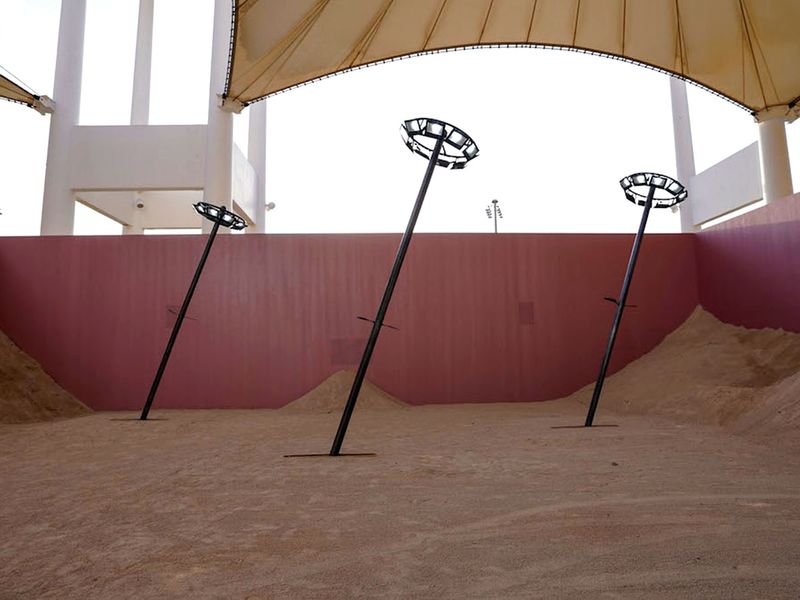
Moreover, the artworks in the exhibition are physically oriented towards the Qiblah or the direction of the sacred Kaaba, the building at the center of Islam’s most important mosque, Masjid al-Haram in Mecca, as if they too were in a call to prayer. The biennale is then divided into six galleries with themes reflective of Islamic ritual: “Adhan: The Call”; “Wudu’: Purification”; “Salah: Prayer”; “Salat Al-Jama’ah: Congregational Prayer”; “Mawt: Mortality”; and “Bait: House of God”.
Of note among the contemporary works on display is Egyptian artist Huda Lutfi’s Inside the Black Enclosure, an installation that draws its inspiration from the ritual act performed by Muslim pilgrims on the first and last days of pilgrimage. The installation work has a ritualistic quality about it—particularly through its myriad Islamic verses embroidered by a team of workers across dark walls that Lutfi says was intended for “meditative purposes.”
“I wanted to create an installation that is in conversation with the notion of the Kaaba as a focus of spiritual pilgrimage,” she tells Gulf News. “This is why I chose one of my favorite Quranic verses that communicate another perspective stressing the idea that Allah is anywhere you might turn.” The repetition of the Quranic Verses prompts the viewer to walk around the cubic room reading them repeatedly. “This immersive experience works only for people who are not afraid of the dark, and this is why I added the soothing sound of water and heartbeat,” she adds. “Going inside the dark enclosure might feel like diving deeply inside your soul.”
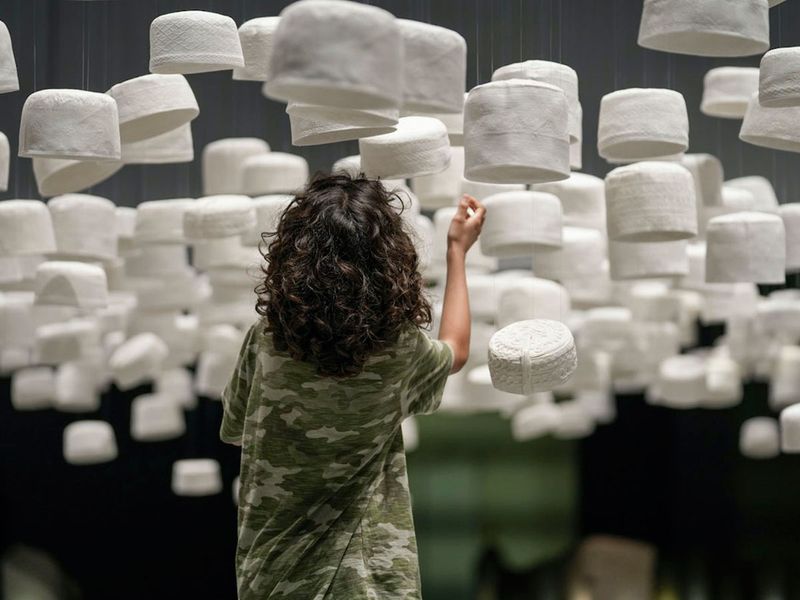
Under the canopy is the installation Air Pilgrims Accommodation 1958 by Jeddah-based architecture and urban research studio Bricklab, founded by brothers Abdulrahman and Turki Gazzaz. The piece reveals the multiculturalism of Hajj reflective through the work’s scaffolding structure that holds found memorabilia taken from a 1950s building complex that had housed pilgrims in Jeddah that was demolished last year. It shows the rich cultural fabric of pilgrims that would flock to Jeddah on their way for Hajj to Islam’s birthplace.
“This modern culture served as a cultural melting pot for all the pilgrims from a variety of cultures coming to Jeddah for Hajj,” the Gazzaz brothers told Gulf News. “These people— from Indonesia, India, Persia, and other parts of the world—would also go outside of the building and sell their things on the street. Once again, they were interacting with Jeddah’s urban fabric and culture.” The Gazzaz brothers explain how the work reflects their engagement and influence on Jeddah’s multicultural identity today.
Ultimately, as the biennale’s artistic director architect Sumayya Vally emphasizes: the biennale is about giving these artworks a new home. “Seeing the Biennale come to life through the voices and perspectives of our artists has been profound,” she said in a statement. “Each of them has boldly and sensitively taken on the opportunity of this platform to contribute to an emerging discourse on Islamic arts that we hope will continue. At its essence, this Biennale is about giving contemporary objects a home by giving them a lineage and giving historic objects a home by giving them a future.”


